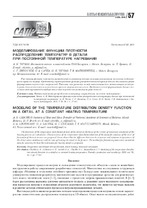| dc.contributor.author | Чичко, А. Н. | ru |
| dc.contributor.author | Лихоузов, С. Г. | ru |
| dc.contributor.author | Сачек, О. А. | ru |
| dc.contributor.author | Чичко, О. И. | ru |
| dc.contributor.author | Матюшинец, Т. В. | ru |
| dc.coverage.spatial | Минск | ru |
| dc.date.accessioned | 2018-07-05T17:07:50Z | |
| dc.date.available | 2018-07-05T17:07:50Z | |
| dc.date.issued | 2018 | |
| dc.identifier.citation | Моделирование функции плотности распределения температур в детали при постоянной температуре нагревания = Modeling of the temperature distribution density function in a detail at a constant heating temperature / А. Н. Чичко [и др.] // Литье и металлургия. - 2018. – № 2 (91). - С. 57-64. | ru |
| dc.identifier.uri | https://rep.bntu.by/handle/data/43537 | |
| dc.description.abstract | Рассчитаны функции плотности распределения температур детали на основе результатов численного моделирования процесса нагрева. Предложены характеристики функции распределения температур детали для анализа уровня формирования термических напряжений. Показано, что разность между максимальными и минимальными температурами детали изменяется нелинейно от времени нагрева детали в печи. Предложен метод формализации данных численного моделирования для выбора наилучших термических режимов нагрева деталей. | ru |
| dc.language.iso | ru | ru |
| dc.publisher | БНТУ | ru |
| dc.subject | Функция плотности распределения температур | ru |
| dc.subject | Нагрев детали | ru |
| dc.subject | Численное моделирование | ru |
| dc.subject | Temperature distribution density function | en |
| dc.subject | Detail heating | en |
| dc.subject | Numerical simulation | en |
| dc.title | Моделирование функции плотности распределения температур в детали при постоянной температуре нагревания | ru |
| dc.title.alternative | Modeling of the temperature distribution density function in a detail at a constant heating temperature | en |
| dc.type | Article | ru |
| local.description.annotation | The functions of the temperature distribution density of the detail on the basis of the results of numerical simulation of the heating process are calculated. Characteristics of the temperature distribution function of the detail for analysis of the level of formation of thermal stresses are proposed. It was shown that the difference between the maximum and minimum temperatures of the detail varies nonlinearly with the time of heating the detail in the furnace. The method for formalizing numerical simulation data for selecting the best thermal modes for heating details is proposed. | en |

